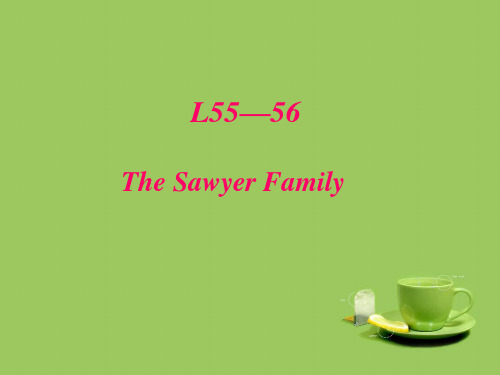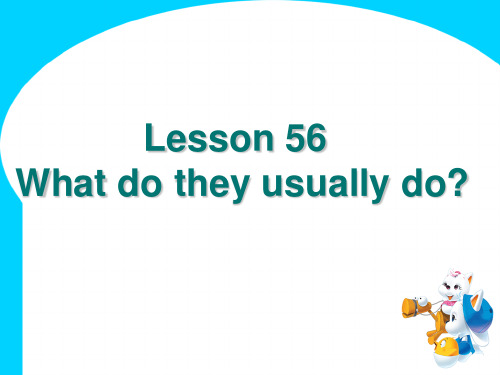新概念第一册教案Lesson56
- 格式:doc
- 大小:30.50 KB
- 文档页数:4






新概念英语第一册55-56课详解Lesson 55-56 of New Concept English Book 1 Detailed Explanation.Lesson 55: The Sawyer Family.Vocabulary and Expressions:live [lɪv] v.: This verb has multiple meanings. Firstly, it can mean to reside or habitually inhabit a place. For example, "I live in Hefei." Secondly, it can mean to exist or be alive, as in "People cannot live without air." Lastly, it can be used in the expression "live a/an... life" to describe the way someone lives their life.stay [steɪ] v.: This Verb primarily means to remain in a place for a period of time. It can also be used figuratively to mean "remain" in a certain state or condition, as in "stay hungry, stay foolish."home [həʊm] n./adv.: As a noun, it refers to the place where one lives. As an adverb, it means "to the place where one lives," as in "go home."housework ['haʊswɜːk] n.: This noun refers to the tasks related to maintaining a household, such as cleaning, cooking, and laundry.lunch [lʌnʃ] n.: This noun refers to the meal eaten in the middle of the day.afternoon [ɑːftə'nuːn] n.: This noun refers to the period of time between noon and evening.Text Explanation:Lesson 55 introduces the Sawyer family and their daily routine. The lesson begins by introducing the family members and their occupations. Mr. Sawyer works in an office, while Mrs. Sawyer stays at home. The children go to school. The lesson then goes on to describe their eveningactivities. Mr. Sawyer usually arrives home from work at about five o'clock, and the family then has their lunch together. In the afternoon, they often have a rest, andthen in the evening, they usually stay at home and watch television.Grammar Points:The use of "-s" or "-es" to form the third-person singular present tense of verbs is reinforced in this lesson. For example, "Mr. Sawyer usually arrives home from work at about five o'clock."The use of prepositions with "live" is also introduced. For example, "Mr. Sawyer lives in a town near London,"where "in" is used with a large place, and "Mrs. Sawyerlives at 87 King Street," where "at" is used with aspecific address.Lesson 56: What Do They Do?Vocabulary and Expressions:together [tə'geðə] adv.: This adverb means "in a group" or "side by side."evening ['iːvnɪŋ] n.: This noun refers to the time of day that comes after afternoon and before night.arrive [ə'raɪv] v.: This Verb means to reach a destination after a journey.night [naɪt] n.: This noun refers to the period of time from sunset to sunrise.Text Explanation:Lesson 56 continues the theme of the Sawyer family's daily life by asking the question, "What do they do?" The lesson provides information about the family's evening activities. Mr. Sawyer usually arrives home from work at about five o'clock, and then the family has their tea together. After tea, they usually sit in the living room and watch television. Sometimes, they go to the cinema orto the theater. On Sundays, they often go for a walk in the park.Grammar Points:The present tense of verbs is reinforced in this lesson, particularly the use of the third-person singular form.The lesson also introduces the use of modal verbs such as "can" and "usually" to express ability and frequency.Conclusion:Lessons 55 and 56 of New Concept English Book 1 focus on the Sawyer family's daily routine and activities. These lessons introduce new vocabulary and expressions related to family life, daily activities, and grammar points such as the use of "-s" or "-es" in the third-person singular present tense and the use of modal verbs. By learning these lessons, students can improve their understanding of family life in English-speaking countries and enhance theirlanguage skills in areas such as vocabulary, grammar, and comprehension.。
Lesson 5 - Nice to meet you. & Lesson 6 - What make is it?每日一句:Practice makes perfect. 熟能生巧。
1.本课重点1、代词:he/she/it的用法。
2、句型:This is....She/ He/It is ....She/ He/It isn’t ....3、词汇:表示“某国”和“某国的”的单词。
2. 教学步骤1)引入课文:大家每天上学,一大早到了学校看到了同桌已经到了,我们要有礼貌的跟同桌打个招呼啊,我们就会说,早上好~当然现在我们已经学了英语,我们就可以说Good morning,早上好~同桌就会觉得你真是个懂礼貌的好朋友。
要是咱们还没到教室呢,就在路上碰到了刚来的新老师,比如说我,大家就可以跟我说Hello ~~也可以说Hi~~但我们要表现的更友好更热情一点,我们就可以说Nice to meet you. 很高兴见到你。
我要怎么回答呢,我说我也很高兴见到你,该怎么说呢?对,Nice to meet you, too. 打过招呼后,老师就会觉得你真是个懂礼貌的小朋友。
今天呢,我们就从Good morning开始~~(跟大家打招呼,Good morning~)在听课文之前,我是要出一个问题的,但今天我先不出问题,让大家先听课文,要仔细听哦~听完后我提了问题要是答出来的话,就有一个小奖励~(课文结束)我的问题是How many students are there? 看学生回答。
6个1.Good morning.早上好。
英语中常见的问候用句。
对此问候的回应一般也是Good morning。
根据一天中见面时间的不同还可以说Good afternoon (下午好)和Good evening(晚上好)。
有时英美人见面时只简单地说一声Hello。
2.This is Miss Sophie Dupont.这位是索菲娅·杜邦小姐。
This is+姓名是将某人介绍给他人时常用的句式。
课文中的例子还有:Sophie, this is Hans. 索菲娅,这位是汉斯。
And this is Naoko. 这位是直子。
找两个学生,互相介绍给对方。
Tom, this is Sam. Sam, this is Tom.注意:介绍别人是有顺序的,一般是先年长后年轻,先上级后下级,先女士后男士。
3.Mr.Blake/Miss Sophie Dupont,布莱克先生/索菲娅·杜邦小姐。
英语国家中人的姓名通常由3部分组成,即:名+中间名+姓。
Rachel Green--- Miss Green First name + Middle name + Last nameGiven name + Middle name + Family name举例:迈克尔·杰克逊Michael Joseph Jackson对照:中国人是姓在前名在后,外国人是名在前姓在后姓冯名韵—冯韵姓Green 名Rachel---Rachel Green 在一般情况下,不用中间名。
在熟悉的人中间,以名相称,而在正式的场合中常用Mr.(先生),Mrs.(太太),Miss(小姐)或Ms.(女士)这些称呼再加上姓。
Mr.用于男士的姓之前,不能单独使用,如课文中的Mr.Blake;而sir 一般单独使用,是对长者、上司或男顾客的尊称,如:Sorry, sir. 对不起,先生。
Miss 一般用于指未婚女子,不过有时在不知道对方是否已婚时也可使用。
练习:Tom Hanks Barack Hussein Obama II Justin Drew Bieber4. Sophie is a new student. 冠词a/an用在单数可数名词之前,表泛指,尤其是第一次出现时。
举例:a book, an eraser, a banana, an apple(注意发音,连读)注意形容词new的位置,放在它所修饰的名词之前。
造句:Linda is a pretty girl. Jim Green is an English teacher.5. She is French. 注意French是形容词,法国的,所以前面不用冠词a/an。
举例:I am Chinese. You are Chinese too. He is American.6. Sophie, this is Hans. 注意这里有个逗号,前面叫的人名是为了引起她的注意,后面才是想要介绍给她的人名。
【Action】让学生自己来相互介绍7.Nice to meet you.很高兴见到你。
用于初次与他人见面等非正式场合。
对方的回应一般应为Nice to meet you,too(我也很高兴见到你)。
人们在正式的场合初次见面时常用:How do you do?相应的回答也是:How do you do?这是一句问候语,并非问话。
8. And this is Naoko. 这里的and是表示递进、并列,没有具体的含义。
9.国籍与国家名称有别请不要将国家名称和与其对应的国籍搞混。
课文的French,German,Japanese,Korean 以及Chinese都是表示国籍的词。
句中表示中国国籍的词应为Chinese 而不是China。
American-America English-England Spanish-Spain Swedish-Sweden Italian-Italia10. She’s Japanese. 复习一下缩写:He is = He’s, She is = She’s, It is = It’s, That is = That’s 4) 语法要点1、代词he/she/it的用法(在代词总表中打钩):(1)he:男性,单数。
she:女性,单数。
it:动物或东西,单数。
(2)练习用合适的代词去代替名词:my father→he, your mother→she, this book→it...(3)做12页的填空题。
(4)造句练习:他是小明。
她是小红。
他是我的哥哥。
她是我的姐姐。
它是一只小狗。
He is Xiaoming. She is Xiaohong. He is my brother. She is my sister. It is a dog.2、某国VS某国的:China - Chinese, America - American, England - English,France - French, Germany - German, Italy - Italian,Japan - Japanese, Korea - Korean, Sweden - Swedish,3、疑问句的三种类型:①特殊疑问句:What’s your name? What’s this?(回答事实内容)以疑问词who,what,when,which,why,where,whose,how 等引导的问句都叫特殊疑问句,也叫疑问词疑问句,有时还被称为wh-问句(wh-question)。
结构一般为:疑问词+助动词+主语+主动词等。
作为疑问词的what可以用来询问名字、国籍、工作、颜色、型号等。
例如以下几个问句:What make is this car? 这辆小汽车是什么牌子的?What nationality are you? 你是哪国人?What is your job? 你的工作是干什么?What colour is it? 它是什么颜色的?What size is this skirt? 这条裙子是多大号的?②一般疑问句:Are you Sam? Is this your handbag?(回答是与否)③选择疑问句:Are you Sam or Tom? Is this a pen or a pencil?(选择一个内容来回答)※判断下面的句子是哪种类型的疑问句:What make is it? Is it a French car? Is it a French car or a Swedish car?4.a 和anSophie is a new student. 索菲娅是一名新学生。
This is an umbrella. 这是一把雨伞。
这两个句子中出现的a/an在英语中被称为不定冠词。
a和an在意义上没有区别。
用a/an 时,我们必须记住两条基本原则:(1)a/an有不确定的意义(即所说的人、动物或东西对听者或读者来说可能是不知道的)。
(2)a/an只能用于单数可数名词之前。
此外还需注意a和an的发音:a(在平时讲话中发/+/音)用于辅音(不是辅音字母)之前;an(/+(/)用于元音(不仅仅是以元音字母a,e,i,o,u开头的词)之前。
当我们把a或an用来说明字母表中的字母时,便会一目了然:This is a B/C/D/G/J/K/P/Q/R/T/U/V/W/Y/Z.这是一个B/C/D/G/J/K/P/Q/R/T/U/V/W/Y/Z字母。
This is an A/E/F/H/I/L/M/N/O/S/X.这是一个A/E/F/H/I/L/M/N/O/S/X字母。
5) 课后练习【联系上Lesson 6】※自己来造一些句子,让别人来分析。
※做12页的仿写句子练习(选择疑问句)。